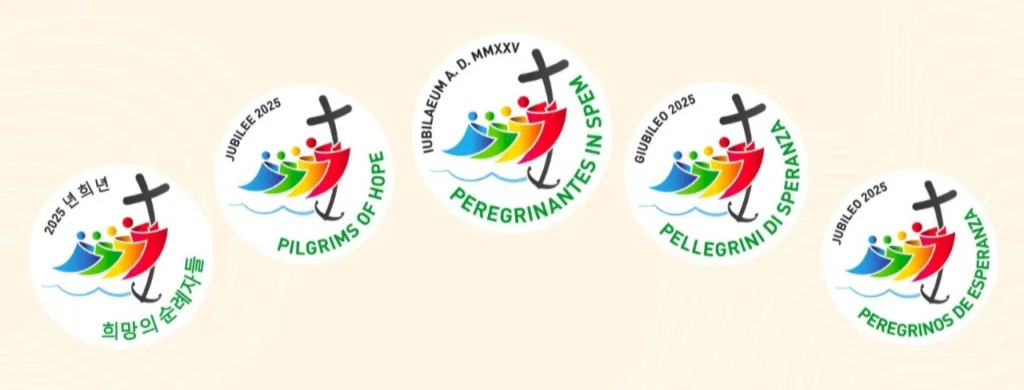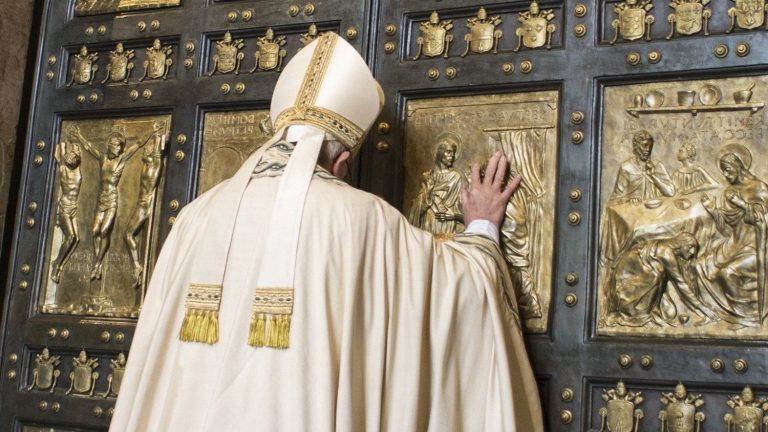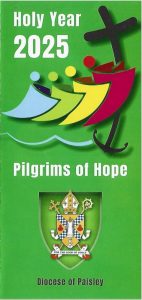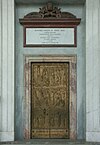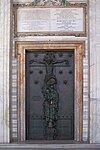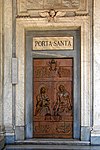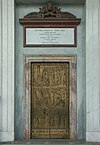Jubilee in the Catholic Church
A jubilee is a special year of remission of sins, debts and universal pardon. In Leviticus, a jubilee year is mentioned to occur every 50th year; during which slaves and prisoners would be freed, debts would be forgiven and the mercies of God would be particularly manifest.
In Western Christianity, the tradition dates to 1300, when Pope Boniface VIII convoked a holy year, following which ordinary jubilees have generally been celebrated every 25 or 50 years, with extraordinary jubilees in addition depending on need. Catholic jubilees, particularly in the Latin Church, generally involve a pilgrimage to a sacred site, normally the city of Rome. The Catholic Church declared an Extraordinary Jubilee of Mercy for 2015–2016. The next jubilee year commenced on 24 December 2024.
In Jewish tradition, the jubilee year was a time of joy, the year of remission or universal pardon. Leviticus 25:10 reads “Thou shalt sanctify the fiftieth year, and shalt proclaim remission to all the inhabitants of thy land: for it is the year of jubilee.”
The same concept forms the fundamental idea of the Christian jubilee. The number 50 was specially associated in the early 13th century with the idea of remission. The translation of the body of Thomas Becket took place in the year 1220, 50 years after his martyrdom. The sermon on that occasion was preached by Cardinal Stephen Langton, who told his hearers that this coincidence was meant by Providence to recall “the mystical virtue of the number fifty, which, as every reader of the sacred page is aware, is the number of remission.”
In the Chronicle of Alberic of Three Fountains, under the year 1208 (rather than 1200), is this brief entry: “It is said that this year was celebrated as the fiftieth year, or the year of jubilee and remission, in the Roman Court.” In Ancient Rome, it was said the jubilee was the celebration coinciding with the centenaries since the founding of Rome; this pagan celebration was co-opted into the tradition of the jubilee.
In Roman Catholic tradition, a jubilee or Holy Year is a year of forgiveness of sins and also the punishment due to sin. It is a year of reconciliation between adversaries, of conversion and receiving the Sacrament of Reconciliation, “…and consequently of solidarity, hope, justice, commitment to serve God with joy and in peace with our brothers and sisters”.A jubilee can be ordinary if it falls after the set period of years or extraordinary if it is proclaimed for some outstanding event.
Ceremonial of the jubilee
The Holy Door by Vico Consorti, cast by Ferdinando Marinelli Artistic Foundry of Florence, is the northernmost entrance of Saint Peter’s Basilica in the Vatican. It is cemented shut and only opened for Jubilee Years.
The most distinctive feature in the ceremonial of the jubilee is the unwalling and the final walling up of the “holy door” in each of the four great basilicas which the pilgrims are required to visit. The doors are opened by the pope at the beginning of the jubilee and then sealed up again afterwards. Previously, the rite included the use of a silver hammer (for removing the concrete at the opening) and a silver trowel (for sealing it again after the jubilee). The pope would pound on the wall, which would then be set to collapse. This ritual caused injury to bystanders, so for the Great Jubilee of 2000, Pope John Paul II simplified the rite considerably, opening and closing the doors with his hands.
Traditionally, the pope himself opens and closes the doors of St. Peter’s Basilica personally, and designates a cardinal to open those of St. John Lateran, St. Mary Major, and St. Paul Outside the Walls. In the Great Jubilee, the pope chose to open all the doors personally, while designating cardinals to close all the doors except that of St. Peter’s.
Catholic parishes all over the world share a similar rite dedicating a door for the purposes of the jubilee year to accommodate its parishioners who do not intend to visit Rome for the occasion. Local parishes’ doors include the same indulgence given to the basilica doors.
Theme Pilgrims of Hope
The theme of the Jubilee in Rome is all encapsulated in the aforementioned motto: “Pilgrims in Hope.” Speaking of the theme chosen for the upcoming Jubilee, Pope Francis emphasized the importance of a deeper spiritual reflection on Mercy, encouraging prayer and a higher awareness of the divine will in our daily lives, through concrete actions of compassion, forgiveness, and solidarity. Furthermore, the Pope recommended that everyone dedicate 2024 to prayer, in preparation for the Jubilee, meditating on the mercy of God the Father and our role as witnesses and active promoters of mercy in the modern world.
This motto sounds like an invitation to walk together, addressed to all Christians and men, to proceed united towards a better future, based on hope, mercy, and fraternity, a continuous journey in search of God and His salvation. The very idea of pilgrimage suggests the communal dimension of the Church: we are all on this journey together, no one is alone in their quest for salvation, in their desire to reconcile with God and neighbour. Indeed, the pilgrimage is an opportunity to witness the joy of the Gospel, share one’s faith with the world, and build a future of peace and fraternity for all.
5 Holy Doors
Jubilee 2025 opens Christmas Eve, Dec. 24, at 7 p.m., with the rite of the opening of the Holy Door at St. Peter’s Basilica in the Vatican immediately before Pope Francis celebrates midnight Mass. Holy Doors will also be opened at Rome’s three other major basilicas: St. John Lateran on Dec. 29, St. Mary Major on Jan. 1, and St. Paul’s Outside the Walls on Jan. 5. Holy Door will also be opened Dec. 26 at Rebibbia Prison, a Roman prison Pope Francis has visited twice before to celebrate Mass and wash inmates’ feet on Holy Thursday.
So what is a Holy Door?
What the Popes Have Said
Pope Francis and St. John Paul II have explained the tradition in official documents.
“In Catholic tradition, the Holy Door represents the passage to salvation — the path to a new and eternal life, which was opened to humanity by Jesus,” explained Pope Francis in Spes Non Confundit (Hope Does Not Disappoint), the papal bull officially proclaiming the Holy Year of 2025.
Jesus said: ‘I am the door’ (John 10:7), in order to make it clear that no one can come to the Father except through him. This designation which Jesus applies to himself testifies to the fact that he alone is the Savior sent by the Father. There is only one way that opens wide the entrance into the life of communion with God: this is Jesus, the one and absolute way to salvation. To him alone can the words of the Psalmist be applied in full truth: ‘This is the door of the Lord where the just may enter’ (Psalm 118:20).”
Opening Date 24th December 2024 , Closing Date 6th January 2026
Opening Date 29th December 2024 , Closing Date 28th December 2025
Opening Date 1st January 2025 , Closing Date 28th December 2025
Opening Date 5th January , Closing Date 28th December 2025
A fifth door, located at the Roman prison in Rebibbia, was opened on 26 December 2024. The act is intended to serve as a symbol “inviting all prisoners to look to the future with hope and a renewed sense of confidence”. This was the first time a prison door has been opened to mark the commencement of a jubilee.
Jubilee 2025 General Calendar
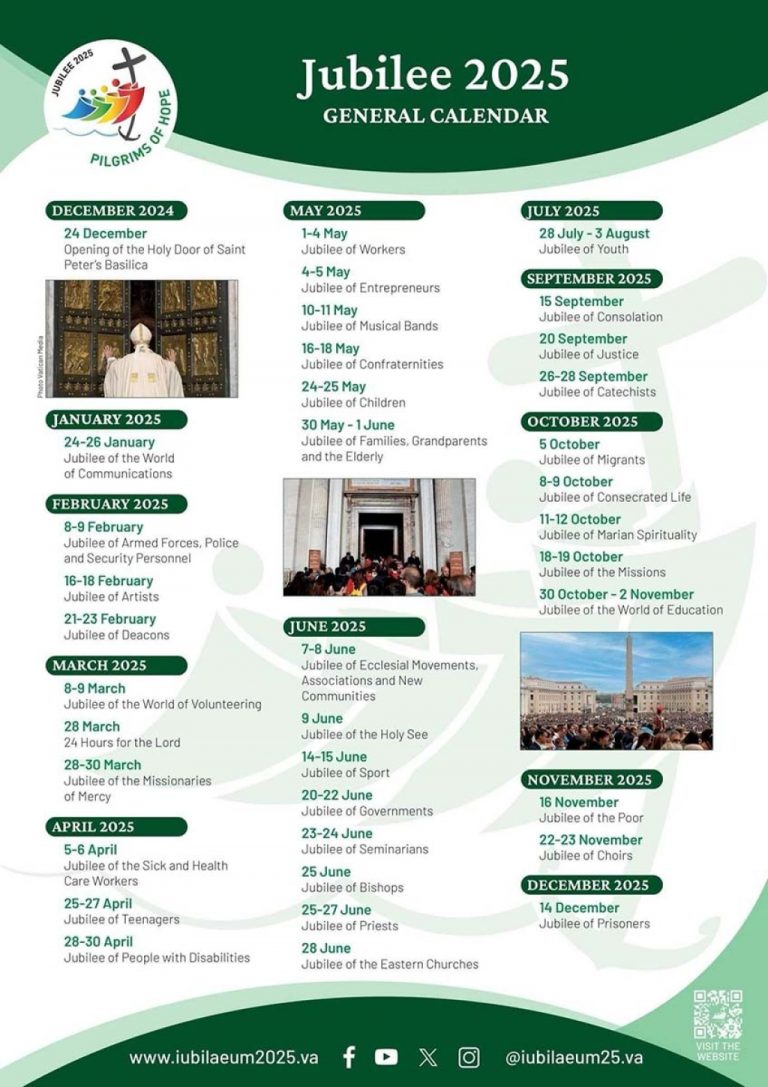
The Jubilee Prayer
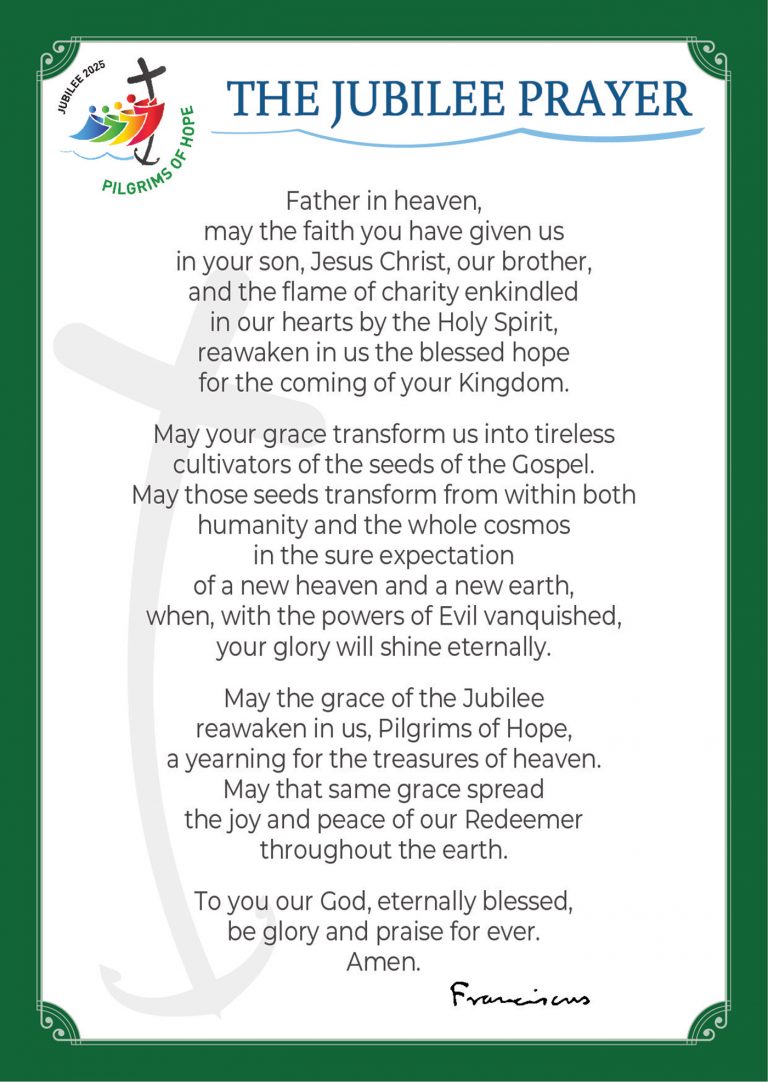
Jubilee Hymn
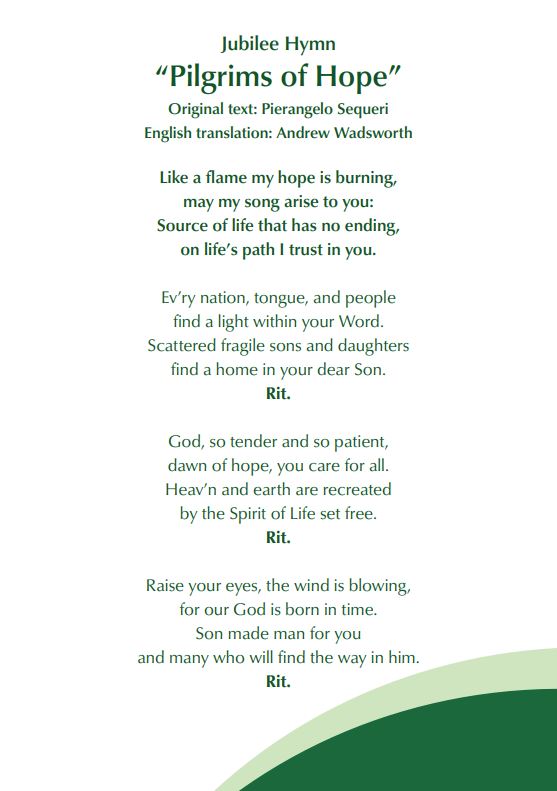
The Jubilee Icon Meaning

The logo chosen for the Holy Year depicts four stylized and graceful figures, in four colours that recall the shades of the rainbow: red, orange, green, and blue. The choice of colours is not random, just as the colour of sacred vestments throughout the liturgical year is not. Red symbolizes love, passion, and self-sacrifice, Christ’s sacrifice and His boundless love for humanity, but also the fire of the Holy Spirit and His strength that animates Christians. Orange expresses joy, vitality, and enthusiasm, the light that illuminates the path of faith. Green is universally recognized as the colour of hope, growth, and rebirth. Blue, finally, symbolizes faith, peace, and tranquillity, evoking the sky and spirituality, and inviting contemplation and prayer.
The four figures represent humanity as a whole, in its differences and similarities. They proceed to embrace each other, expressing the solidarity and brotherhood that should unite the peoples of the world. Leading them is the red figure, clinging to a Cross formed by a black curve that ends, at the bottom, with an anchor. The Cross is not rigid, not static, but bends towards humanity as if to embrace it. As for the anchor, Monsignor Fisichella himself explained its meaning: “As is known, the anchor has often been used as a metaphor for hope. The anchor of hope is the name given in seafaring jargon to the reserve anchor, used by vessels to perform emergency manoeuvres to stabilize the ship during storms.” The sense of this symbol in the Jubilee logo is clear: it is precisely in the most difficult moments that we need to rely on an anchor that gives us security and guarantees salvation, and what better anchor than the Cross, a symbol of Christ and His infinite love for all of us? The presence of small agitated waves at the bottom of the logo confirms the existence of dangers and obstacles, of those personal events and events of the world that make each of our lives not always easy.
Thus, the logo in its entirety takes on a clear meaning, and the Jubilee, with its twelve months of ceremonies and initiatives, becomes a long pilgrimage to be undertaken together, as brothers, towards salvation, guided by the Cross and the hope of salvation promised by God.
Jubilee 2025 Luce Mascot

Luce is the official mascot of the Catholic Church’s 2025 Jubilee. Designed by tokidoki founder Simone Legno, she represents a Catholic pilgrim. She is accompanied by a pet dog named Santino and three friends named Fe, Xin, and Sky.
Luce has blue hair and wears a yellow rain jacket, which is colored in reference to the flag of the Vatican City as well as a symbol for “journeying through life’s storms”. She carries a pilgrim’s staff, which represents “the pilgrimage toward eternity”, and wears mud-stained boots to represent “a long and difficult journey”. Her eyes have highlights in the shape of a scallop shell, a traditional symbol of Catholic pilgrimage; her shining eyes were described as “a symbol of the hope of the heart”. Luce also wears a multi-colored World Mission rosary around her neck.
Simone Legno, Luce’s designer, said that he hoped “Luce can represent the sentiments that resonate in the hearts of the younger generations”.
